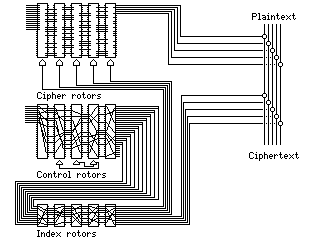
In some ways, the cipher systems outlined in this chapter are disappointing, compared to what we had seen in the previous chapter.
This reflects the difficulty of manipulating binary signals with simple electromechanical devices, and it may also involve the psychological effect of overconfidence in the security of a system based on new and unfamiliar principles.
The M-228 is an exception to both halves of this generalization; it is secure, but it isn't entirely new, being largely based on a rotor mechanism.
Of course, it is true that I could have described the T-52 in more detail (at least in words, for those who cannot recieve the schematic diagrams included in that section, which do accurately describe it). It is certainly very complex. But the complexity and expense of the machine are beyond those of the SIGABA, while the security may well be less even than that of the Enigma. (Yes, it was broken less often than the Enigma; but there were fewer intercepts, and the more restricted distribution of the machine makes it likely that it was more carefully used.) Had the routing of signals to the various inversion and swapping relays changed with every character, instead of merely being a static part of the key, the system might have been significantly more secure. Of course, even more important would be the change to pinwheels instead of cams.
It is interesting that one wire in the Swedish SA-1 seems to hold the key to the security of that machine. That wire is the one from the first pinwheel bank which controls the stepping of the second pinwheel bank. But can something that contains only a single bit of information per five-bit character really provide security?
The M-228 is interesting, and as noted in the section on it, apparently a newer machine existed that was like a SIGABA, except that the cipher rotors were used to encipher teletypewriter signals in the fashion of the M-228.
The following diagram:

illustrates an interesting idea for taking that concept even further. The cipher rotors work like the old M-228, in order to XOR the message with unbiased individual bits. The control rotors are also simplified, so that they can produce five extra signals, which are also XORed with the message.
This appears to strengthen the machine, since bits from two essentially independent sources are XORed with the plaintext. Can we be sure that the bits from the cipher rotors completely mask those from the control rotors, though, or could this design have a weakness, by offering a "window" to the control rotors?